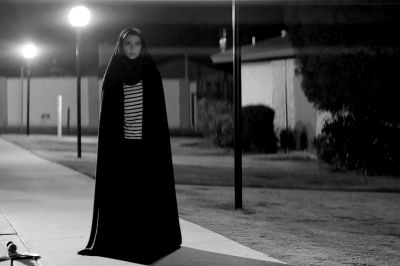By Paul Risker.
A Girl Walks Home Alone At Night (2014) – is it a statement or is it a question? On the one hand it is a statement and yet for any narrative literate spectator it is a question in the shell of a statement – the film an unfolding process of discovering the title character.
Under Ana Lily Amirpour’s directorial eye, A Girl Walks Home Alone At Night is a meticulously crafted film. From the composition of the image to the placement of the actors within the frame, everything is constructed with a meticulous, precise and deliberate touch. On the surface, A Girl Walks Home Alone At Night is an auteur’s film, controlled by Amirpour as if she were a painter stood in front of the canvas; only she is stood behind a camera. She paints not with stillness but with movement, although in moments the movement in the image is so subtle and slight that it almost borders on a conflict between the two. Upon this superficial level which film as a visual art form in part functions, one cannot help but be seduced by the crisp and clean image that is accompanied by the equally crisp sound – the wheels of the skateboard that serves as the vampire’s chariot, footsteps and the sound of car doors opening alongside the voices. The visual stillness and crisp sound creates an unnatural and artificial feel in which the monochrome image lends the film an intoxicating sense of feeling. Upon reflection of Amirpour’s vampiric vision, I felt myself return to the supposition that colour is a contamination of the filmic image, which dulls its definition and sharpness. Amirpour’s choice to paint upon her filmic canvas with charcoal drawings that create a decidedly seductive and pleasing visual aesthetic reminds us that the pulse of black and white cinema has faded only to a faint beat – there is life in it yet.
 All of this lends an ethereal feel to the film; not of a hyper-reality, but of a film torn between reality and a dream world in that way a dream can feel so real and yet is only a dream. Perhaps this is the most apt way to describe this film – a world that feels authentically real in moments, and yet in others has an unshakable sense that on some level it is living and breathing out of the structure of a dream. But what occurs to me about Amirpour’s rendezvous with horror and genre cinema is that films remain a multi-dimensional experience. While the actors are performing for us, the characters they create are performing within the confines of their own world that serves to create a spatial anomaly; a paradox, if you will. In the shadows of the actions of the characters whose movements we are privy to, we see only the effect and not the cause – their inner motivations shielded by their own lack of transparency or conventional reluctance for dramatic purposes. Their actions remain silent and the avoidance of expositional dialogue to explain why and how they feel, they come to resemble either closed flowers or dreamlike figures. But our voyeuristic intrusion allows us to piece together the pieces of the mosaic that make up an image of these characters that goes beneath their skin, or to at least suppose in particular the identity and history of the ‘girl.’ Although throughout there is a shadow cast by Amirpour’s inequality; her opening up of the masculine in contrast to the more ambiguous and insular feminine that only serves to nourish this dreamlike quality with a reversal of the traditional gender roles.
All of this lends an ethereal feel to the film; not of a hyper-reality, but of a film torn between reality and a dream world in that way a dream can feel so real and yet is only a dream. Perhaps this is the most apt way to describe this film – a world that feels authentically real in moments, and yet in others has an unshakable sense that on some level it is living and breathing out of the structure of a dream. But what occurs to me about Amirpour’s rendezvous with horror and genre cinema is that films remain a multi-dimensional experience. While the actors are performing for us, the characters they create are performing within the confines of their own world that serves to create a spatial anomaly; a paradox, if you will. In the shadows of the actions of the characters whose movements we are privy to, we see only the effect and not the cause – their inner motivations shielded by their own lack of transparency or conventional reluctance for dramatic purposes. Their actions remain silent and the avoidance of expositional dialogue to explain why and how they feel, they come to resemble either closed flowers or dreamlike figures. But our voyeuristic intrusion allows us to piece together the pieces of the mosaic that make up an image of these characters that goes beneath their skin, or to at least suppose in particular the identity and history of the ‘girl.’ Although throughout there is a shadow cast by Amirpour’s inequality; her opening up of the masculine in contrast to the more ambiguous and insular feminine that only serves to nourish this dreamlike quality with a reversal of the traditional gender roles.
An ambiguous character, Sheila Vand’s performance by embracing the art of silence captures the ‘girl’s’ predatory nature and yet an emotional undercurrent indicates a sense of melancholic tragedy that has come to infuse the vampire character. The ‘girl’ drills to the lonely core of the vampire; of a character trapped in a world that is caught in the cycle of life and death, and in whose shadow she lives while contributing only death. The vampire inherently belongs to a world that is dying around them as they continue to live; both active and inactive participants in the death and rebirth of human civilization. The mix of silence and archetypal tragedy draw us into her character and the metaphorical imagery of machinery drilling for oil is an effective piece of symbolism of the draining of life. While the ‘girl’ continues to live, like her vampiric brethren in part she feels the weight of immortality upon her shoulders. Despite escaping mortality, she appears to be withering just as the world around her continues to evolve through death; her misery intertwined within this contradictory dance with death.
 The silent era of film has been buried by decades of film history, and yet A Girl Walks Home Alone At Night seems to look back over its shoulder to the spectre of the old art form that it embraces. One almost feels that there is an ode being sung by Amirpour, who is seemingly paying tribute to the American cinema of yesteryear – the troubled American teen movies and, in particular, James Dean, echoes of who reverberate from her own troubled leading man, played by Arash Marandi. Despite the inescapable impression of being a product of film history, A Girl Walks Home Alone At Night, channeled through Amirpour’s creative vision, is able to find its own language. She creates something whose roots feel familiar, and yet it is difficult to deny its beguiling presence. It has the feel of a collision between the past and the present and while it is a film that could not have been encountered in the past, the influence of the past intertwines itself into its fabric to leave a stark impression within this latest addition to the cinematic vampire canon.
The silent era of film has been buried by decades of film history, and yet A Girl Walks Home Alone At Night seems to look back over its shoulder to the spectre of the old art form that it embraces. One almost feels that there is an ode being sung by Amirpour, who is seemingly paying tribute to the American cinema of yesteryear – the troubled American teen movies and, in particular, James Dean, echoes of who reverberate from her own troubled leading man, played by Arash Marandi. Despite the inescapable impression of being a product of film history, A Girl Walks Home Alone At Night, channeled through Amirpour’s creative vision, is able to find its own language. She creates something whose roots feel familiar, and yet it is difficult to deny its beguiling presence. It has the feel of a collision between the past and the present and while it is a film that could not have been encountered in the past, the influence of the past intertwines itself into its fabric to leave a stark impression within this latest addition to the cinematic vampire canon.
The setting for Amirpour’s film has given the film the tantalizing selling point of an Iranian vampire picture. In the current political climate, Islam and areas with large Islamic populations has, for the western world, become today’s ‘Other’. While Bad City may, to all intents and purposes, be a fictional setting, the preconceptions of the audience will undoubtedly influence the nature of their interaction with this vampire tale. Similar to Nina Forever (2015) and Under The Skin (2014) whose British setting showed how a unique sense of feeling and the identity of a film is invariably linked to its spatial settings, A Girl Walks Home Alone At Night’s use of the spatial is a little more complex. As aforementioned, the film is torn between past and present; reality and a dream. Speaking with Sheila Vand about the spatial setting and how aware of its influence she was during the shoot, she explained: “Especially because of the way that it fused American and Irani elements, I knew that no matter how the movie panned out it was going to have a unique voice: one that doesn’t exist yet.” It is an over simplification of the film to assert that any fresh breeze is the exclusive result of the setting, when in fact it is the combination of a handful of aspects. But it cannot be denied that the sense of feeling that derives from a film and its core identity is influenced by its space. Mentioning the potential for the hybrid combination to serve to keep cinema fresh, original and with forward momentum, Vand offered: “Any time you are combining more than one thing or another then you are going to arrive at a new place. This movie, in particular, brought the right ingredients together, and it seems that is why it is resonating with people, because all its pieces are just as strong as the whole.”
Amirpour’s approach is not one of progression through the exploration of avenues as she moves on through the narrative. Rather it is to hover over the world she has created; her approach inferring a refusal to lose herself in the narrative. Within A Girl Walks Home Alone At Night there is something in the superficial, where narrative details that are dwarfed by the sense of feeling of hovering on by are mirrored in the motion of the skateboarding title character. The film creates a feeling similar to a dream – a part of it not accessible to your conscious state upon exiting the filmic experience. Just as the title poses a question, the film itself leaves us to ask the question whether Amirpour is enacting a stylistic magic trick; misdirecting us from the truth that A Girl Walks Home Alone At Night is a superficial film posing as a masterpiece. There may be some trickery afoot.
Paul Risker is a critic and writer for a number of on-line and print publications, including Little White Lies, Flickering Myth, Starburst Magazine, and VideoScope. He is currently based in the United Kingdom.

